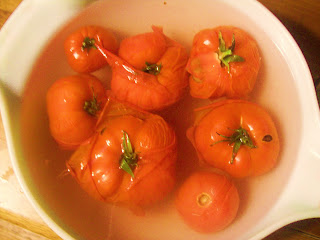We are swimming in tomatoes (and fruit flies) around these parts. I was originally very worried about our tomato harvest since June was the rainiest on record and then September started raining early as well. Apparently the Karma Gods realized we had been very diligent with our hope and smiled upon us. The last 2 weeks in September were gorgeous, filled with lots of sun and a few 80 degree days. Total craziness for our area.
What it has meant is quite a nice selection of red tomatoes all at once. After a few days of clouds, you hit 80 and 15 tomatoes ripen all at once. After 3 days of sun, even though The Barracuda tries he cannot eat that many tomatoes.
The only creatures that were more excited than The Barracuda, were the fruit flies. We considered drying the tomatoes, but opted for stewed tomatoes and tomato paste instead. Though a few dried ones will be nice for backpacking, stewed tomatoes will be used far more often and could take care of many tomatoes all at once.
The Brandywine tomatoes we have grown in the past are really great producers of large, meaty fruits. This year there were 6 Brandywines, 3 Arkansas Travelers, and 3 Mortgage Litter. We were pleased with all of them, though the Mortgage Litters didn't do as well this year as they have in the past. They seem to like more early sun exposure and just couldn't seem to catch up this year.
Before tomatoes can be processed in the pressure canner, they need to be peeled. If you can them without peeling, they tend to all split up and you get weird deformed tomatoes and floating skins. It isn't exactly the kind of thing you want to dump into some rice or soup. Luckily, peeling tomatoes is quick and often kinda fun. (However, you should take into a count that I might just be a sadist. This might be toilsome as all get out and our family is just weird.)


Next it is into the boiling water bath for about 1 minute. This water needs to be boiling, not just hot. I tried hot and was sorely disappointed. There were soggy tomatoes all over the counter until the water was reheated up to boiling. When the skins begin to blister and split, use a ladle to retrieve the tomatoes and place them in the ice bath. Do not try to handle them as they are crazy hot. The only reason for the ice bath is to cool them down to the point you can handle them, so the water doesn't need to stay icy cold.
Only do about 8 tomatoes at once or they will get too hot and begin to fall apart before you can peel them. Secondly, only fill the containers up about half way since the tomatoes will bring the water level up once they are thrown in.
 They peel really easily at this point so be delicate with them. When you want to put them in the jars, it is time to manhandle them. The smaller ones tend to plop themselves right in, but some of our Brandywines were quite large. These were ripped apart and cored as we went. Smush them into the jars. There is no need to worry about adding any liquid as they tend to juice themselves when pushed down in the jars and cooked.
They peel really easily at this point so be delicate with them. When you want to put them in the jars, it is time to manhandle them. The smaller ones tend to plop themselves right in, but some of our Brandywines were quite large. These were ripped apart and cored as we went. Smush them into the jars. There is no need to worry about adding any liquid as they tend to juice themselves when pushed down in the jars and cooked.
The color of these tomatoes is ridiculously vibrant. They are like technicolor tomatoes. They make me wonder just how on long in advance the stewed tomatoes in the stores were picked before they were processed.
When we didn't have enough to make a full canning load, the tomatoes were peeled and then cooked down to paste. The paste was then frozen. Due to viscosity and differing acid levels, it is better to freeze tomato paste than can it. Luckily, you don't need nearly as much paste from homegrown tomatoes as you do from the store purchased kind.














0 thoughts:
Post a Comment